|
Me Sahyadri |
|
December 2017 |
|
Volume 4, number12, # 54 |
|
|
Please use minimum 1280 pixel horizontal screen resolution for viewing. Please be patient while all the images in webpage are loaded. Please do not use the images for any commercial use without permission. Text in Marathi and English is not exact translation. Please give sufficient time to allow the photographs to load. Special thanks to all those who helped me during the compilation and for the help and guidance during the activity. |
|
|
|
|
देशाची आर्थिक प्रगती व्हावी असे सर्व नागरिकांना वाटणे सहाजिक आहे. अर्थकारणामुळे मिळणारा रोजगार, समृद्धी यासाठी सर्वांनाच आर्थिक प्रगती हवी हवीशी वाटते. आर्थिक प्रगती होताना, त्याचा दिर्घकाळात समाजावर, निसर्गावर, वातावरणावर दुष्परिणाम होणार नाही याची काळजी घेणे महत्वाचे आहे. मनुष्याच्या भावी पिढ्यांना पाणी, शुद्ध हवा, योग्य वातावरण मिळत रहावे अशी भावना मनात रुजणे महत्वाचे आहे. वाढत्या आर्थिक प्रगतीमुळे नैसर्गिक संपदेवर ताण येतो. प्रगतीसाठी प्रदुषण होते. जंगले, माळराने, व इतर अधिवास नष्ट होतात. वसुंधरेवर रहाणाऱ्या इतर जीवांचा मात्र मनुष्य फारसा विचार करत नाही. आर्थिक प्रगती करताना, मनुष्य निसर्गाची हानी करत आहे. मुळताच माणसाला निसर्गाचे महत्व समजणे हे सध्याच्या आपल्या प्रगत जीवनशैली मुळे अवघड झाले आहे. आर्थिक प्रगती, समाजाची प्रगती व निसर्ग संपदेची निगा, यांचा समतोल राखणे काळाची गरज आहे.
सह्याद्री (पश्चिम घाट) हा एक नैसर्गिक संपदेचा, वैविध्यतेचा, भौगोलिक व ऐतिहासिक ठेवा आहे. वाढत्या मानवी अतिक्रमणाचा, सह्याद्रीच्या विविध घटकांवर होणारा दुष्परिणाम भविष्यात आपल्यालाच धोका निर्माण करेल, यात शंका नाही. शुद्ध पाणी, हवा व उर्जा, भावी पिढीला मिळण्यासाठी, नंद्यांचे उगम असलेला सह्याद्री व त्याभागातील जंगले टिकवणे महत्वाचे आहे. सह्याद्रीच्या महत्वाच्या घटकांचे महत्व छायाचित्रांद्वारे प्रकट करण्याचा मी येथे प्रयत्न केला आहे. येथील पक्षी, प्राणी, वनस्पती, अधिवास, किल्ले व लेणी अशा विविध विषयांबद्दल आपण समजुन घेऊ.
|
|
As the economic development has taken the center stage, the balance between the environmental sustenance and socio economic development will be under the scanner. As most experts with balanced views have proclaimed, Indian wildlife and ecological system sustenance will be under threat, unless precautions are taken with the help of appropriate research and long term national interests. As we encounter the economic development, many habitats which indirectly or directly help sustainable development will be damaged. The awareness to gauge the success by sustainable development and not by year to year growth is a distant dream any environmentalist will assume in current scenario.
Western ghats, or Sahyadri as we all call it as, is a treasure trove of spectacular landscapes, biodiversity, flora, fauna, some amazing geological wonders and man made monuments. With the increasing pressure from human encroachment, all these elements are under stress and in turn are under depletion. Western ghats should be left untouched by human beings, to protect their future generations from getting short of resources, such as water, energy and clean air. The important elements of western ghats, which need protection are highlighted in the new version of Photo journal, Me Sahyadri Magazine. The current issue has some photographs and information about the grassland hills of north western ghats in the rain shadow region east of Pune.
|
|
|
| |
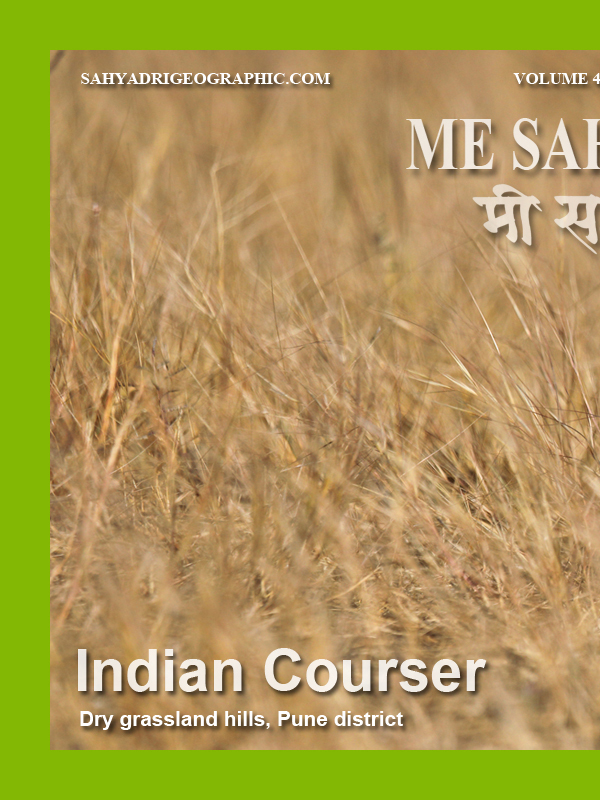 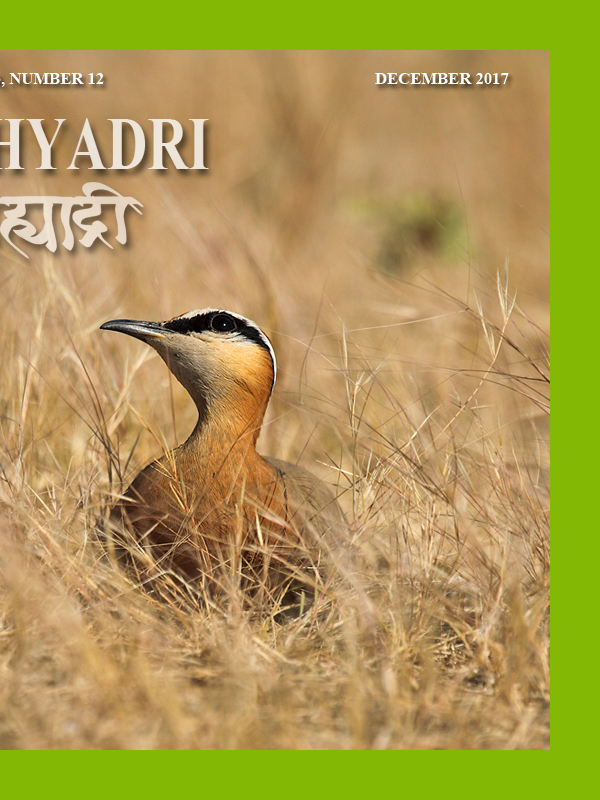
|
| |
| Me Sahyadri – December 2017
|
| |
|
|
सुर्याची तिरपी किरण जेंव्हा गवताळ माळरानावर पडतात तेंव्हा सोनेरी जरीला सुद्धा लाजवेल अशी त्याची झळाळी असते. ओसाड दिसणाऱ्या माळरानावर लहान मोठया पाखरांची चहलपहल सुरु होते. थंडी पडल्यावर उत्तरेकडच्या शुष्क प्रदेशांतुन आलेल्या पाहुण्यांचे थवे माळावर अचानक उंचावतात. आकाश विविध जातींच्या चंडोल पक्ष्यांच्या उंच भराऱ्यांनी जीवंत होते. मुरारी पक्षी मंजुळ शीळ वाजवु लागतात. कुठुन तरी उडत उडत आलेल्या भाट तित्तरांच्या जोड़्या गवतावर उतरतात. गवताचे बी टिपत टिपत गवतात चालता चालता त्या गवतात हरवुन जातात.
दुपारी माळावर खेळ करणारे डोंबारी पक्षी माळावर विखुरलेल्या दगडांवर उन्ह खात बसलेले दिसतात. कोरफडीच्या शेंड़्यांवर गप्पीदास आपली शान दाखवत बसलेले दिसतात. हिरवे लहान राघू भुंगे, चतुर यांना पकडण्यासाठी हवेत करामत करतात. कोतवाल आपल्या इलाख्याची निगराणी करतात. उत्तरेकडुन आलेले विविध जातींचे बंटिंग बाजरीच्या कणसांवर आपला हिस्सा खाण्यात मग्न असतात. लावा पक्षी शेतांच्या बांधावरच्या गवतात दडत दडत अचानक रस्ता ओलांडताना दिसतात. हवा तापण्याची वाट पहात लहान टेकड़्यांच्या टोकांवर कझाकी स्टेप गरुड शांत बसलेले आढळतात. बाभळीच्या झाडावरुन होले माळावरच्या वाटेवर अलगद उतरले. सातबाया जाग्या झाल्या. बिळातुन बाहेर पडलेल्या घोरपडीकडे पाहुन सातबायांचा कलकलाट चालु झाला.
चिंकारा हरणे लहान कळपात सावध सावध डोंगराच्या बाजु बाजुने चरताना दिसतात. कापशी घार हवेत एकाच ठिकाणी फडफड करत शिकारीची तयारी करताना दिसते. ससाणे माळावरच्या मीटर भर उंच आकाशातुन आपले सावज शोधत तरंगतात. रात्र भर शिकार शोधुन शोधुन दमलेले तरस, कोल्हे, लांडगे आपल्या आपल्या जमिनीखालच्या अड़्यांमध्ये निजलेले असतात. अचानक गवतात लगभग होते. १०-१२ धावक पक्षी गवतात दुडदुडत किडे शोधु लागतात. बांधावरुन पिवळ्या गालाच्या माळ टिटव्या निरिक्षण करु लागतात. एव्हाना ससे शोधत शोधत कझाकी स्टेप गरुड आकाशात रिंगण घालु लागतात.
इकडे धनगराच्या वाघुरातुन धुराच्या वेलांट्या बाहेर पडु लागल्या. पुढचे पाय बांधलेले चार भीमथडी घोडे गवतावर चरत चरत येतात. बाभळीच्या काटेरी वाघुरातून धनगराच्या शेळ्या मेंढ्याचा कळप बाहेर पडतो. त्यांच्या मागे मागे दोन रंगीत पागोटी, एक गडद लाल आणी एक गडद गुलाबी संगतीने बाहेर पडतात. पागोटयांच्या खाली जाड मिश्या असतात. संगतीला घोंगडी, लांब निमुळते शेकाटे असा लवाजमा माळापल्याडच्या डगरीवरुन पुढे दिसेनासा होतो. सोनेरी माळावरची थंड हवा एव्हाना तापु लागते. माळरानांवर आता कुंपणे आली आहेत. वाट अडल्याने चिंकारे चिंतेत दिसतात. गवतावरचे चार मीटर उंच आकाश आपली दुनिया समजणारे ससाणे कुठे तरंगणार हा अजुन एक प्रश्न आहे.
माळावर शासनाने पुण्यासाठी नवे विमानतळ होऊ घातले आहे. सर्व्हे चालु आहेत. गावकऱ्यांनी आपल्या जमिनींचे तुकडे पाडुन विकण्यास सुरुवात केली आहे. सर्वत्र कुंपणांचा पसारा वाढत आहे. चिंकारा हरणांना कुंपण, गावातली कुत्री आणी लहान होत चाललेल्या अधिवासाचा सामना करणे भाग पडत आहे.
हळू हळू सूर्य डगर सोडून बराच वर आला. माळरानावर रखरख वाढू लागली. पाखरांचा कलकलाट कमी झाला.
|
|
As the sun rises above the barren rocky hills after the cold starry night, the golden light spreads over the yellow grassland. The grass glitters with golden sparkle. The sun brings little warmth in early morning cold breeze. The birds on the dry grassland leave their roosting places in the acacia trees and the bushes. The migratory birds from the north and resident birds make a gala on the grassland in the winter. The migratory larks start making synchronised acrobatic movements in the flocks in the sky, sometimes showing their grey upperwings and sometimes their white underbodies.
The resident rufous tailed larks make beautiful light whistles adding the light melody to the wind melody. The pairs of chestnut bellied sandgrouse land from the sky and start walking fast picking the seeds from the soil under the grass. They soon are lost in the barren landscape thanks to their amazing plumage camouflaged with respect to the habitat. The acrobate lark species, the ashy crowned sparrow larks are seen basking in the morning sun on the rocks.
The bush chats are seen on the thorny aloe vera tips while the green bee eaters are busy catching the damselflies and bees in the mid air with intermittent perching on their favourite fence wires and acacia branches. As usual the drongos are doing their job of policing. The bajra and maize fields are invaded by the huge flocks of the migratory buntings. The frankolins are making their morning titir titir calls, while walking briskly over the mounds. The rock bush quails are busy in the foliage and the bushes and are hardly seen due to their amazing camouflage. The steppy eagles are patiently seating on the hill tops waiting for the air to get warmed up so that they can take their flights.
The Chinkara gazzels are seen cautiously feeding on the grass on the hills away from the human habitation. The devil eyed, black shouldered kites are seen hovering above the grassland looking for their food. The harriers are seen floating in the sky just few meters above the grassland, constantly looking for their food, with their heads down. While the nocturnal animals like wolfs and hyenas are now resting in their dens, suddenly one can see heard of grazing sheeps followed by their nomadic human masters. The colourful turbans, large moustaches and long bamboo stick follow these large sheep heards only to disappear beyond the horizon. After landing the courser birds are seen running on the grass before they start picking the beetles in the grass. By the time sun heats up the air, one can see the steppe eagles high up in the sky making rounds and rounds.
While this is happening the humans are busy fencing the land plots, preparing for the economic boom they see in the future of this dry grassland thanks to the proposed new Airport.
|
|
|
| |
  |
| The banner has been published here to improve the awareness of the trekkers and tourists visiting the various mountain forts, mountains in north western ghats. Please avoid accidents, by following good outdoor ethics such as no swimming in cisterns at mountain forts, no rock climbing without proper technical equipment and expertise. Please do not adventure, trek with any group or individually without understanding the risks associated. The frequency of the solo trekker fatalities have increased recently. Please strictly avoid solo treks. Please also avoid treks to mountains in large commercial groups, as it leads to damage to biodiversity of these high elevation ecological islands. Please respect the wildlife and biodiversity of the region. This has become more important as the ever increasing human interference is leading to severe damage to fragile ecosystems. Please be aware of the wildlife and biodiversity of the mountains before visiting these mountains. Please follow outdoor ethics. Follow ASI and Forest department rules. The concept of use of symbols for outdoor ethics was conceived and designed by "Sahyadri Trekker Bloggers Group". |
| |
|
|
| |
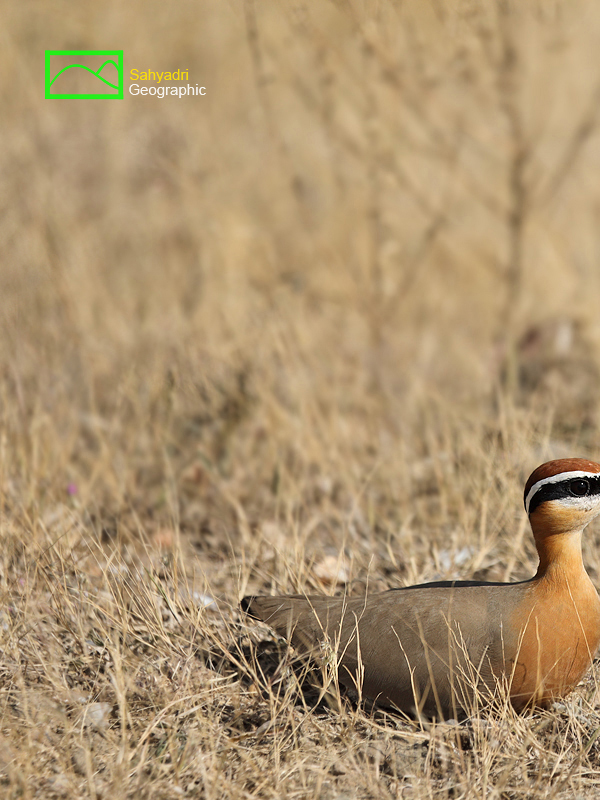  |
| |
| 1. Indian Courser, Dry grassland, Pune district, Maharashtra, India |
| |
|
|
धाविक हा पक्षी गवताळ माळरानावर रहातो. त्याच्या या अधिवासात लपणारे अशी त्याची रंगभुषा असते. पक्ष्यांच्या गटागटाने ते गवतात फिरताना आढळतात. कोर्सर पक्ष्याच्या तीन जाती भारतात आढळतात. इंडियन कोर्सर (धाविक) , क्रिम कलर्ड कोर्सर (फिका धाविक), जेर्डोन कोर्सर या तीन जातींपैकी महाराष्ट्रातील माळरानांवर इंडियन कोर्सर (धाविक) आढळतो. ओसाड माळराने, शुष्क प्रदेश हा त्याचा अधिवास आहे. कमी उंचीच्या गवताळ माळरानांवर तो प्रामुख्याने आढळतो. आकाशातुन जमिनीवर उतरताना हे पक्षी जमिनीला समांतर तरंगत हळुवार जमिनीवर उतरतात. उतरल्यावर ते धावत धावत वेग कमी करुन स्थिरावतात. म्हणुन त्यांना धाविक असे म्हणतात. उंच सफेद पाय, फिक्या तपकिरी रंगाचा व डोळ्यांवर सफेद आडवी लकेर असे याचे रुप असते.
हे पक्षी गवतातले किडे खातात. आय यु सि एन संस्थेच्या वर्गिकरणानुसार हा पक्षी "लिस्ट कन्सर्ण्ड" श्रेणीत आहे.
दुर्दैवाने गवताळ माळरान म्हणजे निरुपयोगी जमिन या मानवाच्या धारणेमुळे वेगाने याचा माळरान अधिवास लुप्त होत आहे. मोकळ्या रानावर उघड़्यावरच घरटे करणाऱ्या या पक्ष्याच्या संख्येत शहरीकरणामुळे घट होताना दिसते.
शहरांजवळची माळराने झपाटयाने कमी होत आहेत. औद्योगिकरणामुळे आणी शहरीकरणामुळे गवताळ माळराने नष्ट होत आहेत. त्यामुळे हे पक्षी या भागातुन दिसेनासे होत आहेत.
|
|
Indian courser known scientifically as Cursorius coromandelicus is one of the three species of coursers found in India. It is a bird from Cursorius genus.The other coursers found in India are viz. the cream coloured courser from Cursorius genus and the rare and critically endangered nocturnal Jerdon’s courser from Rhinoptilus genus. The Indian courser is one of the enigmatic birds of Indian dry grasslands and arid region. These birds are often seen in small flocks. They nest in open in dry rocky grasslands. Coursers walk in the grass looking for the food. These birds walk a lot and are called as "dhaavik" in Marathi, meaning the runners. These birds run a short distance after landing.
Their camouflage is very interesting and is called as obliterative coloration.(graduating tones, with colors which are same as the habitat) Their crown is rich rufous.The black strips pass through the eyes and the white strip pass above the eyes merging together at the neck behind. Their legs are long with beautiful silver white coloration. The bird is very elegant. Often the bird is seen in very small grassland strips in the midst of cultivated farms.
As per IUCN red list classification the bird is “Least Concern” species. Unfortunately its habitat is being destroyed around the urban regions due to agricultural and industrial activities.
|
|
|
| |
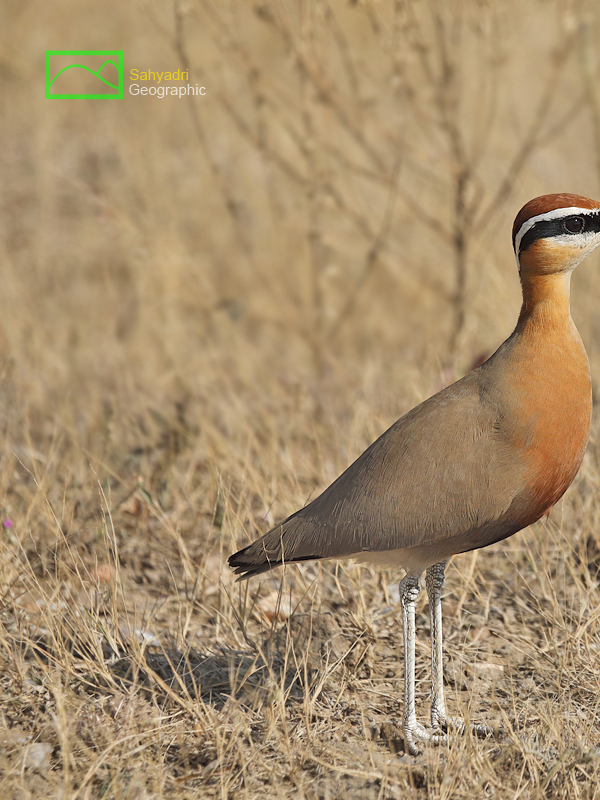 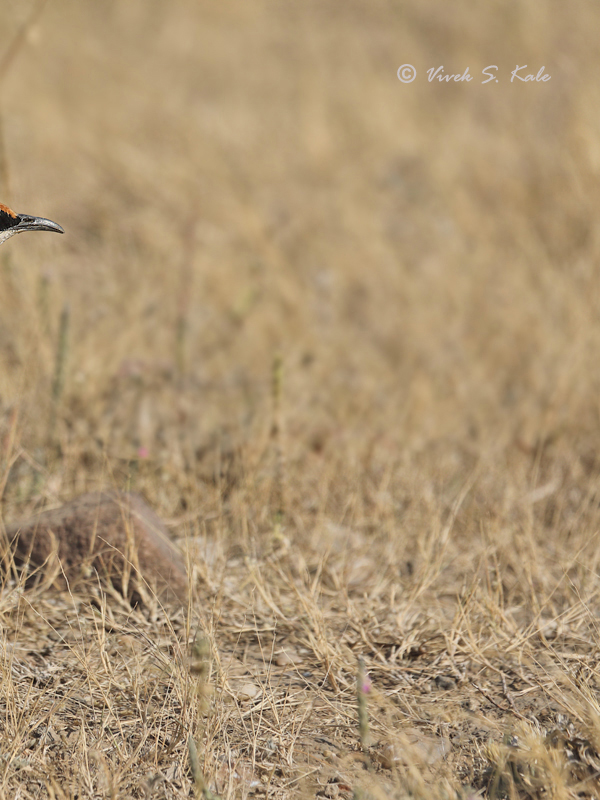 |
| |
| 2. Indian Courser, Dry grassland, Pune district, Maharashtra, India |
| |
|
|
| |
 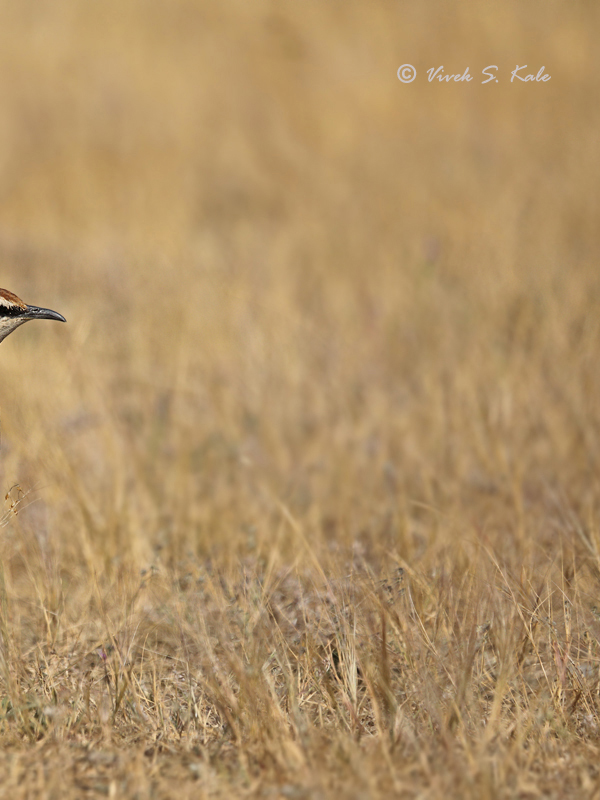 |
| |
| 3. Indian Courser, Dry grassland, Pune district, Maharashtra, India |
| |
|
|
इंडियन कोर्सर (धाविक) पक्ष्यांचा विणी चा हंगाम मध्य भारतात एप्रिल ते जुन दरम्यान असतो. पुर्वेकडे त्यांचा विणीचा हंगाम मे ते जुन दरम्यान असतो. तर पश्चिम भारतात मार्च ते जुलै काळात ते अंडी देतात. हे पक्षी घरटे तयार करत नाहीत. ते जमिनीवर उघड़्यावर अंडी उबवतात. धाविकाच्या अंड़्यांचा रंग आजबाजुच्या जमिनीशी मिळता जुळता असतो. जमिनीवरच्या दगड गोटयांमध्ये त्याची अंडी शिकारी प्राण्यांना सहज दिसत नाहीत. मातकट रंगाच्या अंड़्यांवर काळपट तपकिरी रेघा व ठिपके असतात.
|
|
Nesting :
Indian courser breeds in central India from April to June, in western India from March to July and in east coast dry zones in May and June. It breeds just before and at the onset of monsoon. The bird does not build the nest. It lays the eggs on the bare ground in the middle of the rocks and pebbles. The two eggs are typically of the exact same colour and pattern as that of the ground where the eggs are laid. The eggs are pale stone to rich brown buff with black or yellow markings consisting lines & smears.
|
|
|
| |
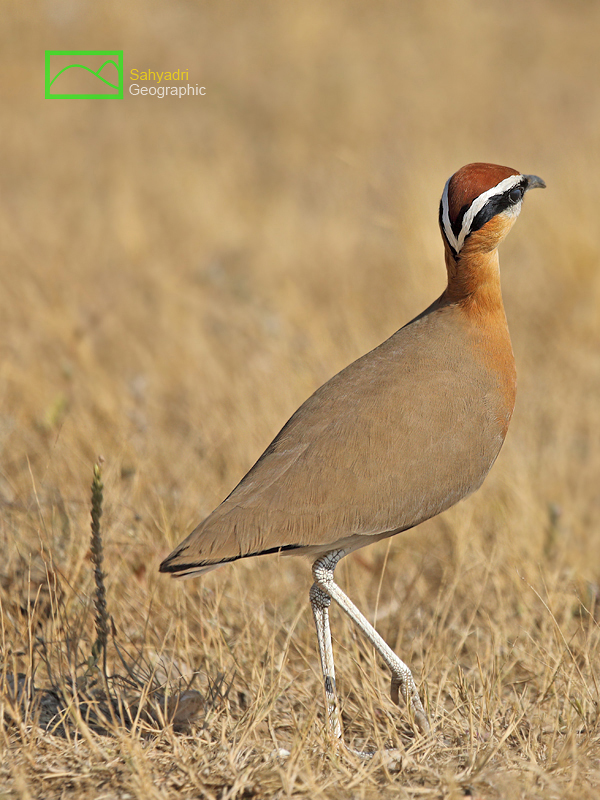  |
| |
| 4. Indian Courser, Dry grassland, Pune district, Maharashtra, India |
| |
|
|
| |
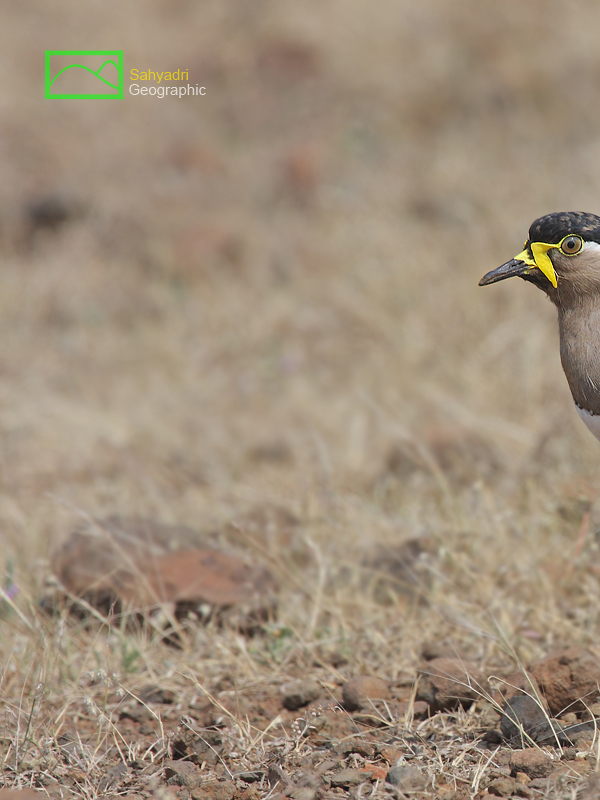 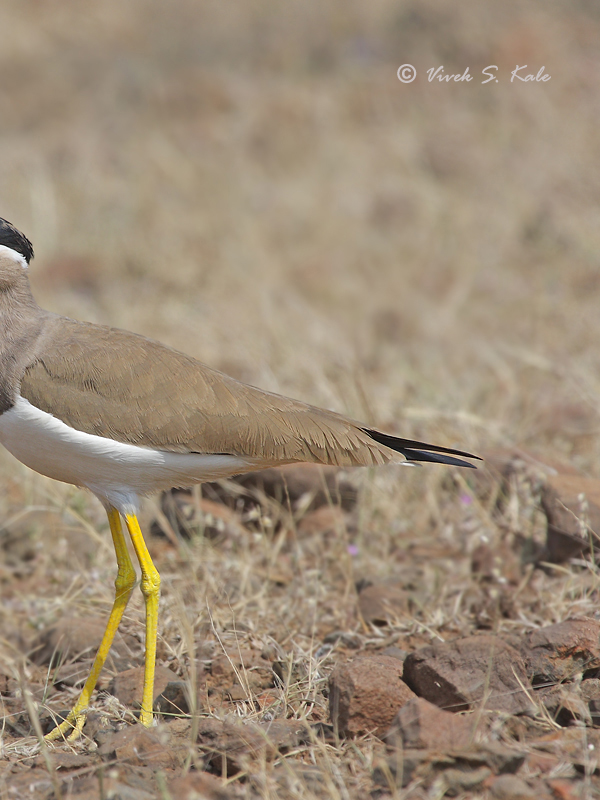 |
| |
| 5. Yellow wattled lapwing, Dry grassland, Pune district, Maharashtra, India |
| |
|
|
| |
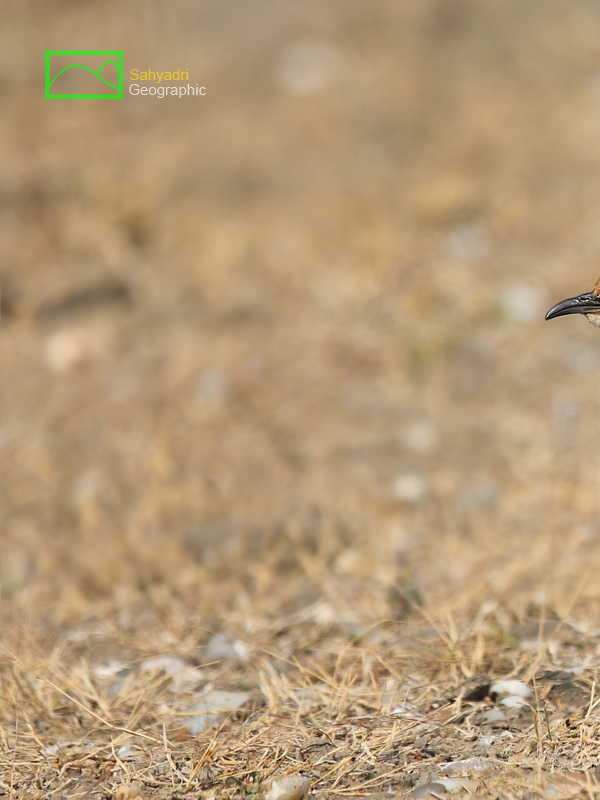  |
| |
| 6. Indian Courser, Dry grassland, Pune district, Maharashtra, India |
| |
|
|
| |
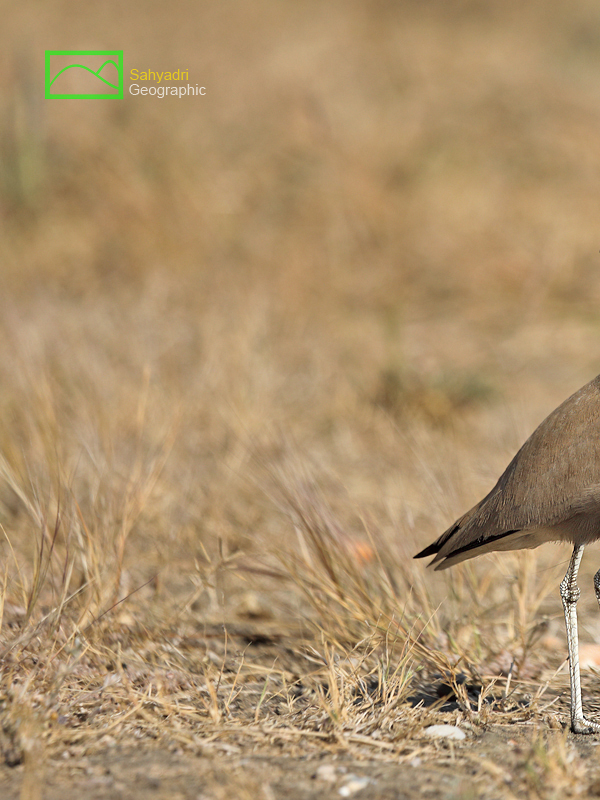 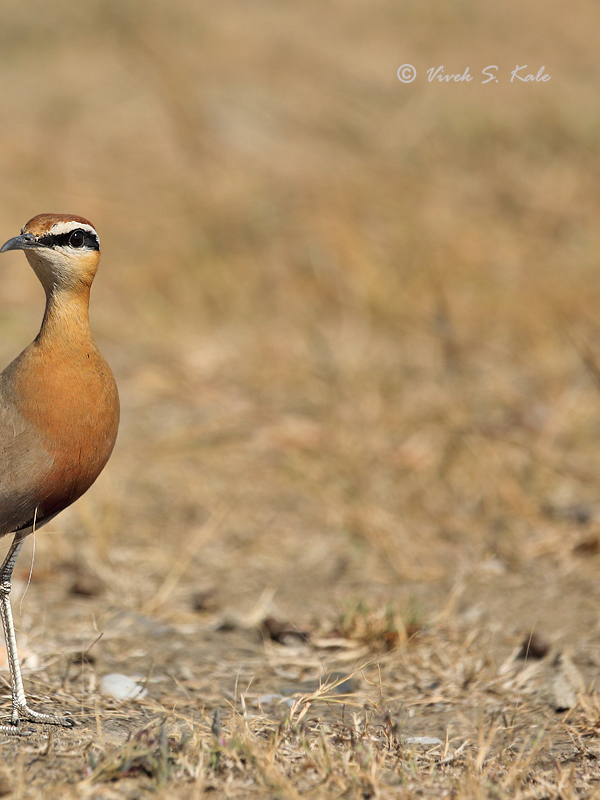 |
| |
| 7. Indian Courser, Dry grassland, Pune district, Maharashtra, India |
| |
|
|
इंडियन कोर्सर (धाविक) पक्षी ज्या भागात खुप पाऊस होतो अश्या भागात आढळत नाहीत. ते ज्या भागात अजिबात पाऊस होत नाही अशा भागात देखील आढ्ळत नाहीत. धाविक पक्षी मोकळ्या माळरानांवर दिसतात. ते शेती असलेल्या आणी बिगरशेतीच्या जमिनींवर मोकळ्या माळरानांवर गवताळ भागात किडे खाताना आढळतात. धाविक लाजरा पक्षी आहे. त्याच्या जवळ गेल्यास तो दुर दुर पर्यंत धावत निघुन जातो. त्याला फार धोक्क जाणवला तर तो ग्वाट ग्वाट असा आवाज करतो आणि वेळ प्रसंगी उडुन जातो. ते काही अंतरावर जाउन पुन्हा जमिनीवर उतरतात. उतरल्यावर थोडे अंतर चालत जाऊन पुन्हा गवतातले किडे खाण्य़ात मग्न होतात.
|
|
Habits :
Indian courser is not found in areas where it hardly rains. Howevere it also is not found in areas where it rains heavy. It is found in open country, cultivated or otherwise, on the land which is covered with the low scattered grass. It is a shy bird. When disturbed it runs away on the ground. If the disturbance approaches it at the very close distance, it flies away after giving a brief warning call to its flock. It is insectivorous bird. It is found in pairs or in small flocks. They run in spurts on the ground but take to flight with a hoarse creaky gwaat call. The flight is strong with rapid wing beats. They fly low and begin to run after landing.
|
|
|
| |
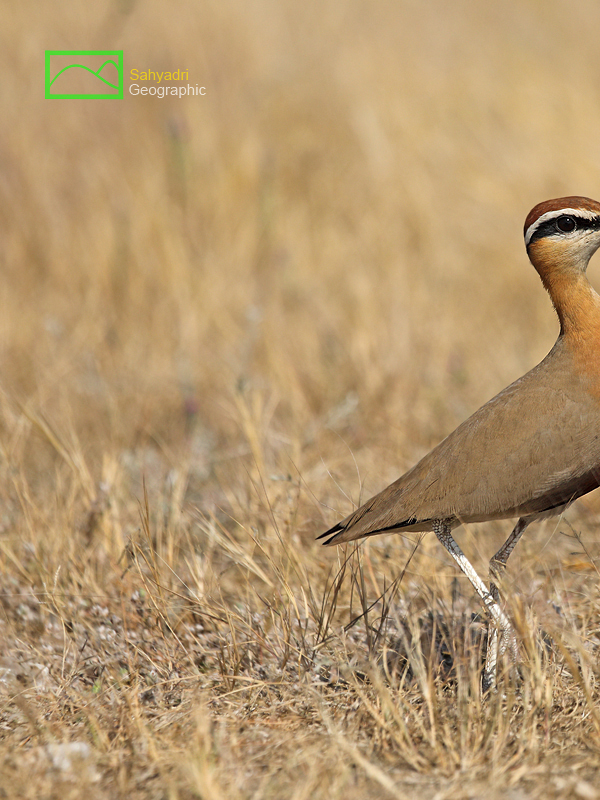 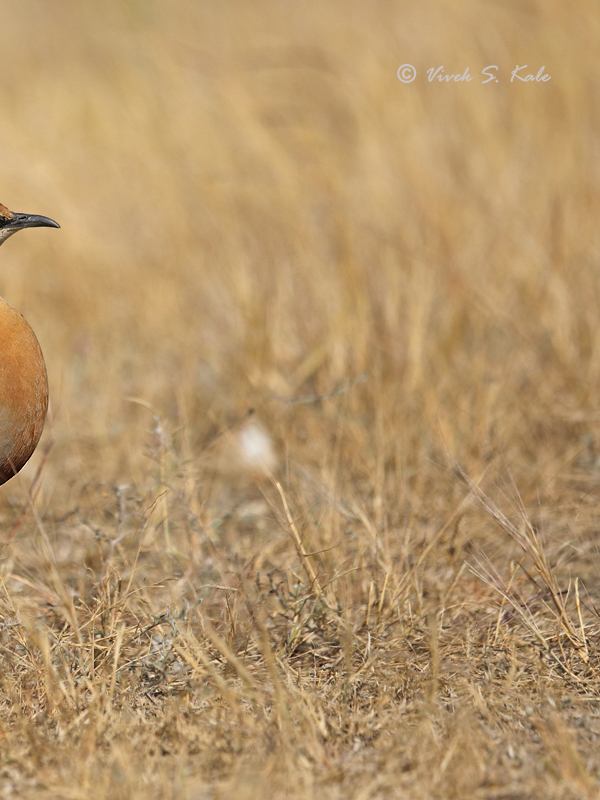 |
| |
| 8. Indian Courser, Dry grassland, Pune district, Maharashtra, India |
| |
|
|
| |
 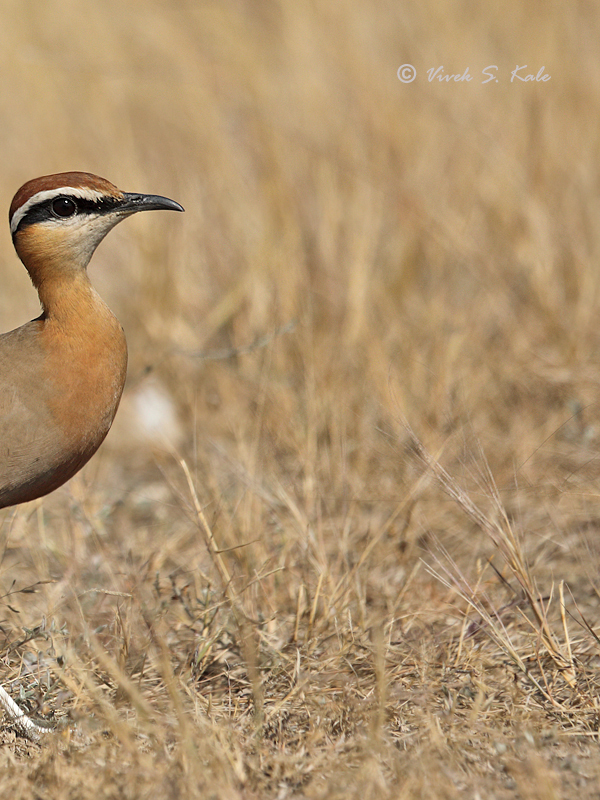 |
| |
| 9. Indian Courser, Dry grassland, Pune district, Maharashtra, India |
| |
|
|
| |
 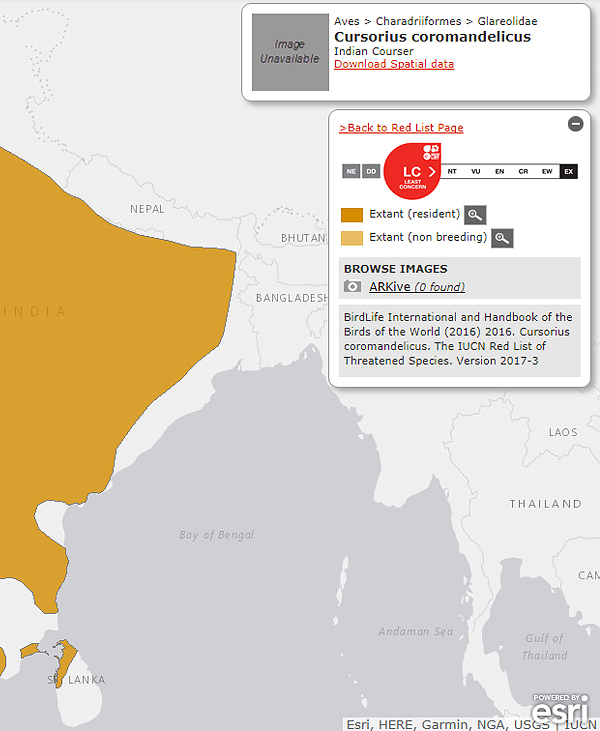 |
| |
| 10. Distribution of Indian courser, IUCN, Pune district, Maharashtra, India |
| |
|
|
इंडियन कोर्सर (धाविक) पक्षी मध्यम पाऊस असलेल्या शुष्क प्रदेशात गवताळ माळरानांवर आढळतात. हे पक्षी वाळवंटात आढळत नाहीत. त्याच प्रमाणे ते समुद्रकिनारी आढळत नाहीत. पुर्वेकडच्या कोरोमंडल भागात प्रथम आढळले म्हणुन त्यांचे शास्त्रीय नाव क्युर्सोरिअस कोरोमन्डेलिकस असे देण्यात आले आहे. इंडियन कोर्सर (धाविक) पक्षी भारत, नेपाळ, श्रीलंका आणि बांग्लादेशात आढळतात.
|
|
Distribution :
Indian courser is found in drier and open regions in India.It is absent in wet coastal region and the desert region. It is also found in north Srilanka. In southern India, the drier zone on the east coast, the Coromandel region, gives it the species name. The bird is seen in India, Srilanka, Pakistan, Nepal and Bangladesh.
|
|
|
| |
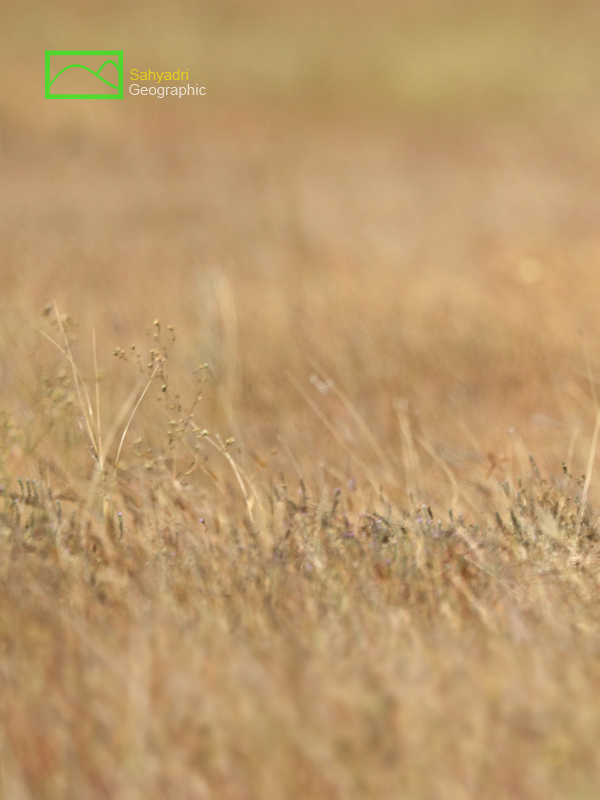  |
| |
| 11. Indian Courser, Dry grassland, Pune district, Maharashtra, India |
| |
|
|
| |
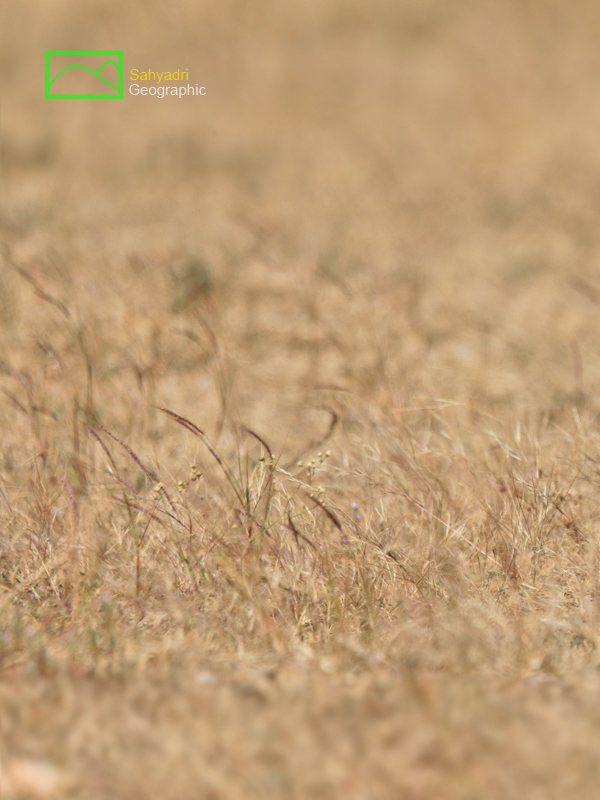 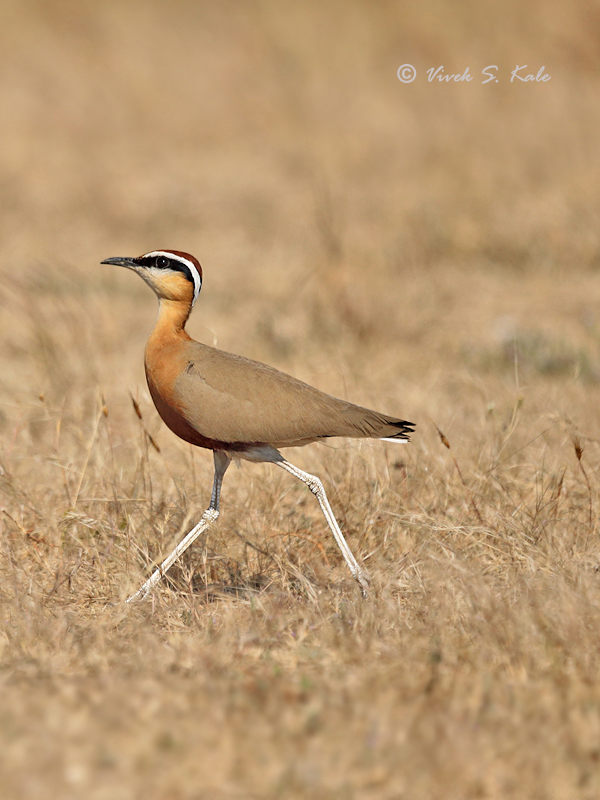 |
| |
| 12. Indian Courser, Dry grassland, Pune district, Maharashtra, India |
| |
|
|
| |
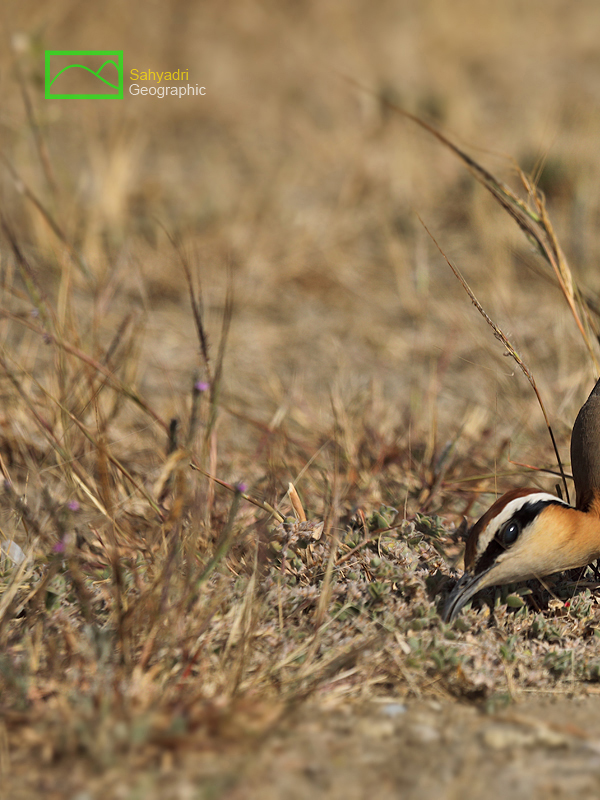 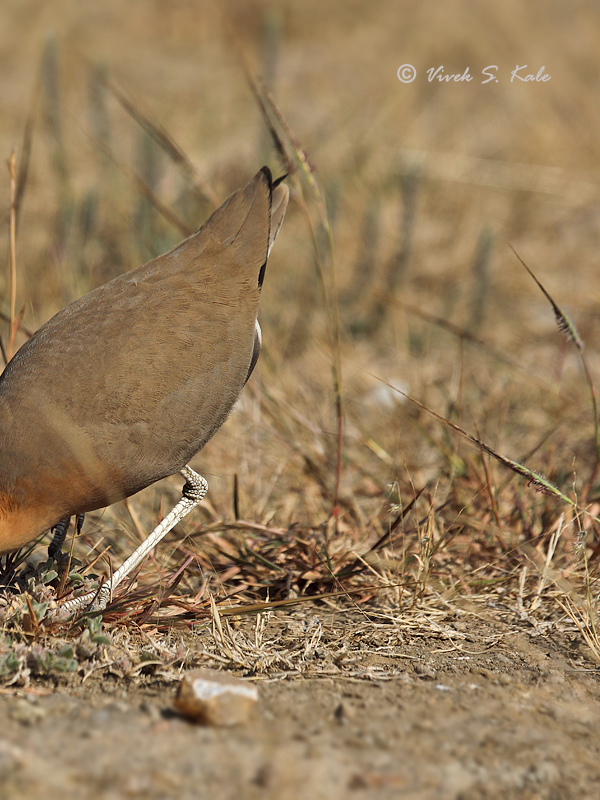 |
| |
| 13. Indian Courser, Dry grassland, Pune district, Maharashtra, India |
| |
|
|
| |
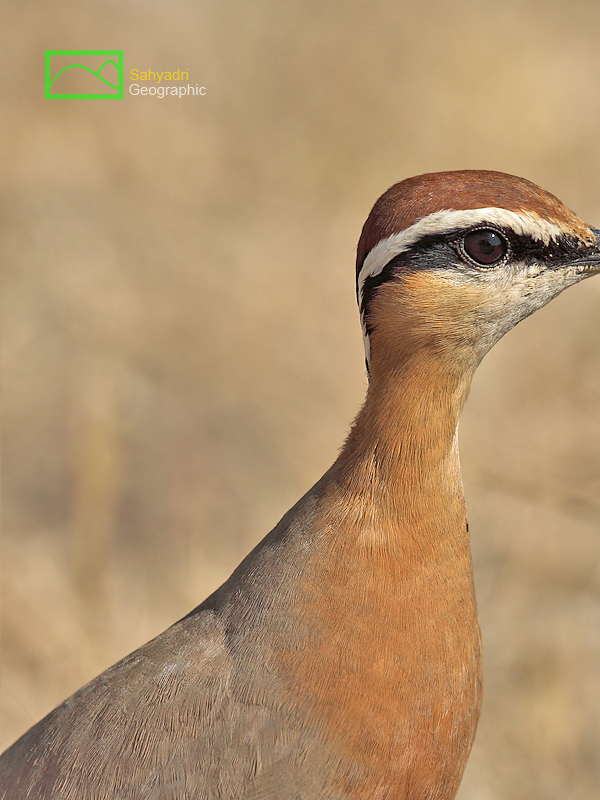 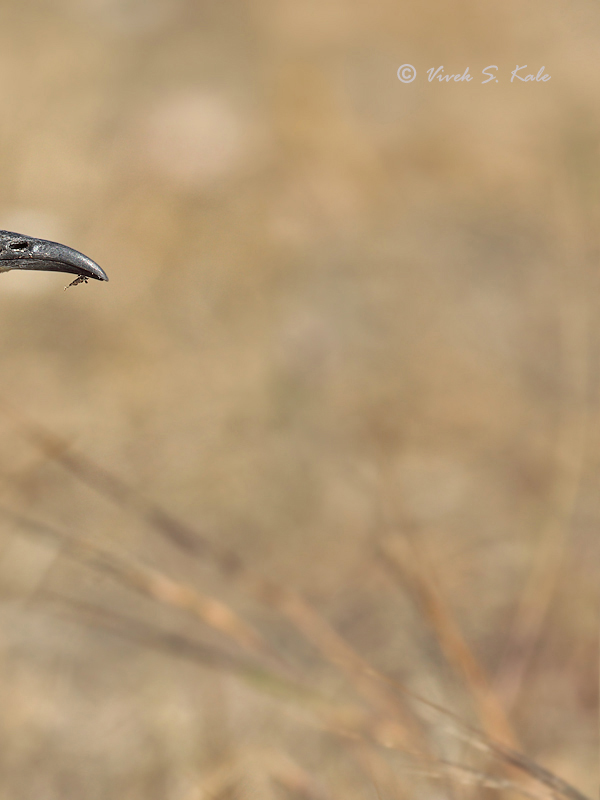 |
| |
| 14. Indian Courser, Dry grassland, Pune district, Maharashtra, India |
| |
|
|
इंडियन कोर्सर (धाविक) पक्ष्यांत नर आणि मादी सारखेच दिसतात. या पक्ष्याच्या डोक्यावर विटकरी तपकिरी रंग असतो. डोळ्यावर सफेद पट्टी असते. दोन डोळयांवरच्या या सफेद पट्ट्या मानेकडे एकत्र येतात. डोळ्यावरुन संमांतर काळ्या पट्ट्या असतात. त्या पट्ट्या देखील मानेकडे एकत्र येतात. धाविकाची मानेकडे विटकरी तपकिरी रंग असतो. धाविकाचा पंखांचा बाह्य भाग तपकिरी करड़्या रंगाचा असतो, तर मानेकडुन खालचा छातीकडचा, पोटाकडचा भाग चेस्टनट तपकिरी रंगाचा असतो. त्याची चोच काळी असते. धाविकाचे पाय सफेद रंगाचे असतात. तर डोळ्यातले बुबुळ तपकिरी रंगाचे असते.
|
|
Description :
Indian courser male and female birds look same. The adult bird has rich rufous crown. It has broad white supercilium running from the front of the eyes to the nape where the supercilum meet. The lores are black. The black band starting from the lores run over the eyes, ending at the nape. Its hind neck is rufous. Its upper plumage is light brown. Its breast and flank are chestnut coloured, deepening on the abdomen. Iris is dark brown. Its legs are ivory white. Courser’s beak is black.
|
|
|
| |
 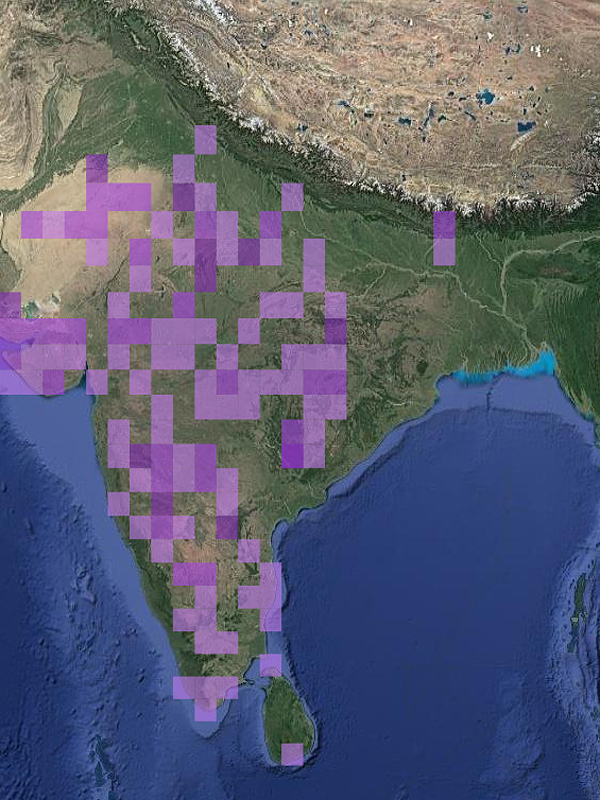 |
| |
| 15. Distribution of Indian courser, E birds, Pune district, Maharashtra, India |
| |
|
|
| |
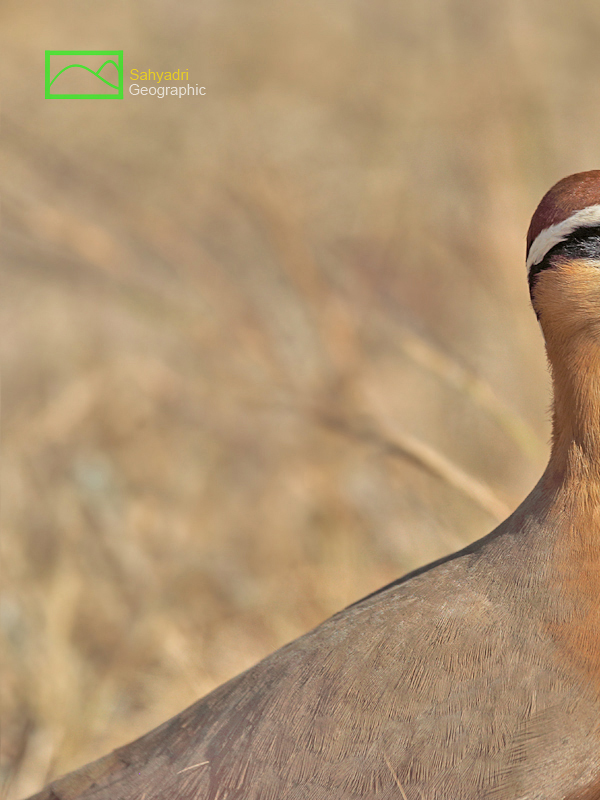 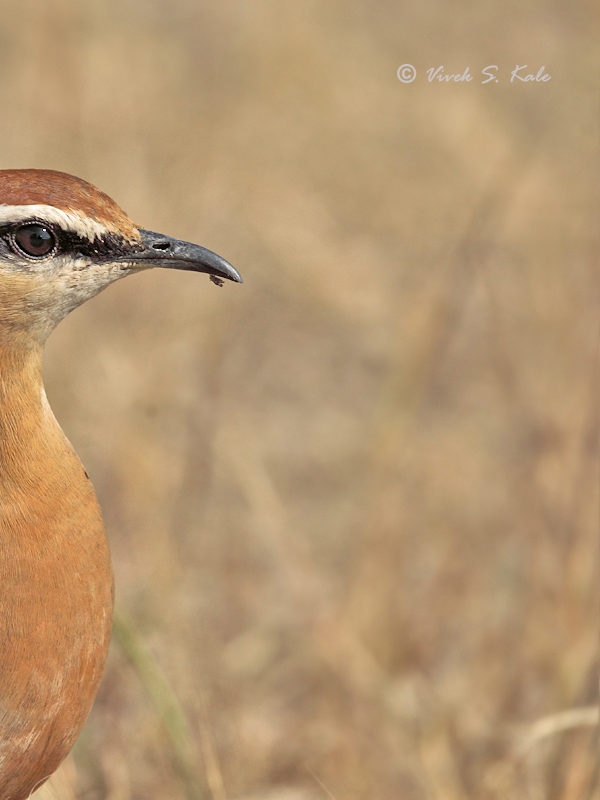 |
| |
| 16. Indian Courser, Dry grassland, Pune district, Maharashtra, India |
| |
|
|
| |
 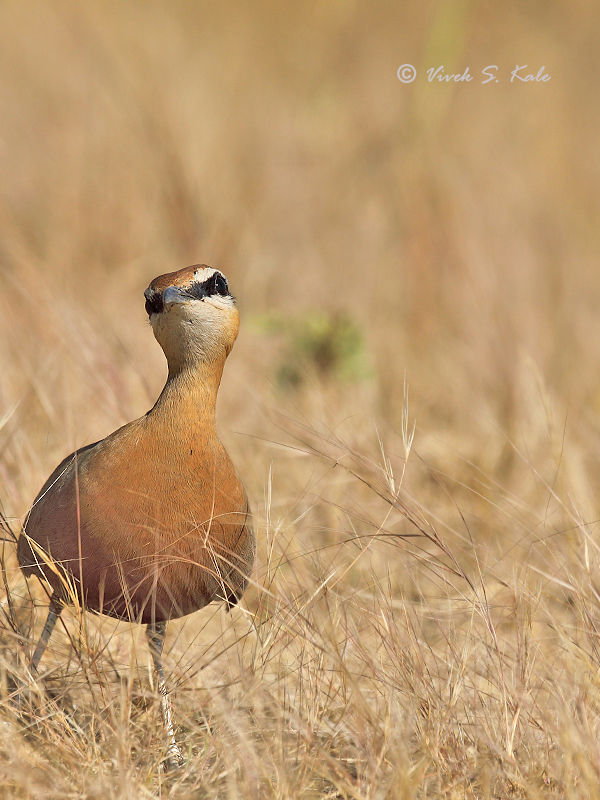 |
| |
| 17. Indian Courser, Dry grassland, Pune district, Maharashtra, India |
| |
|
|
| |
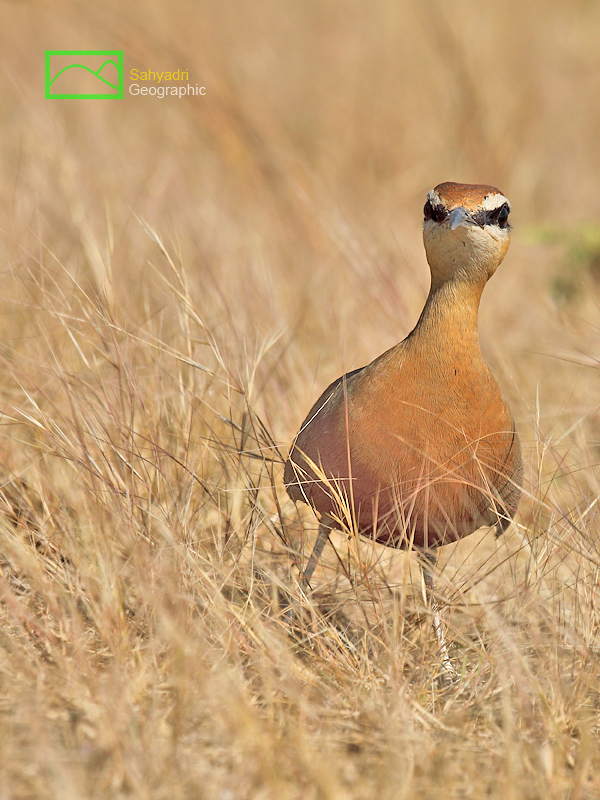 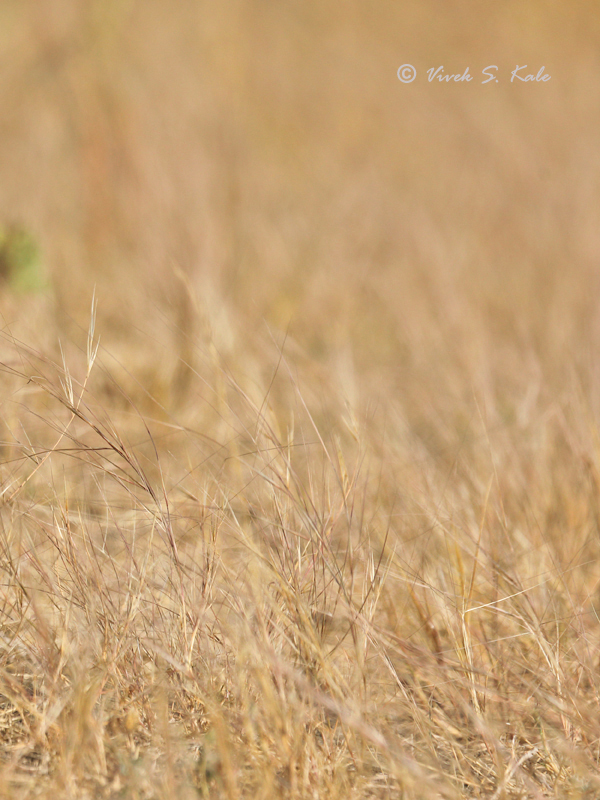 |
| |
| 18. Indian Courser, Dry grassland, Pune district, Maharashtra, India |
| |
|
|
| |
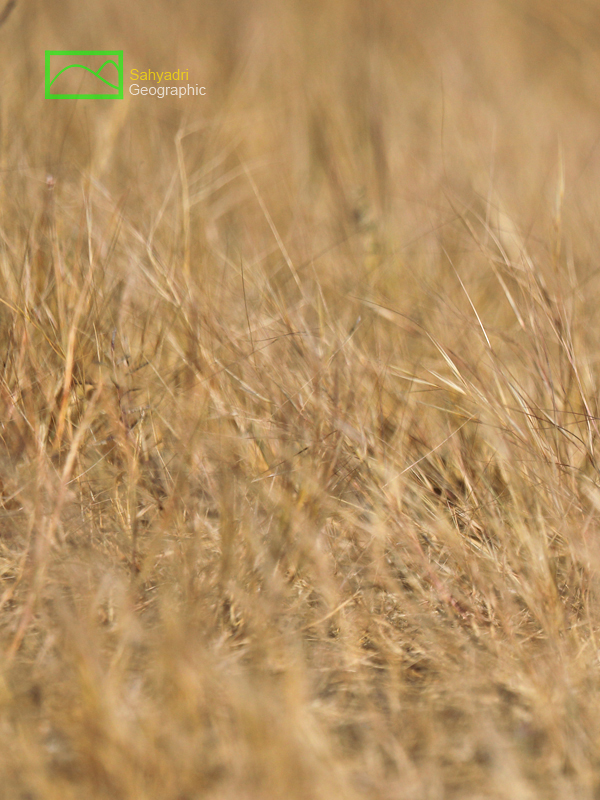 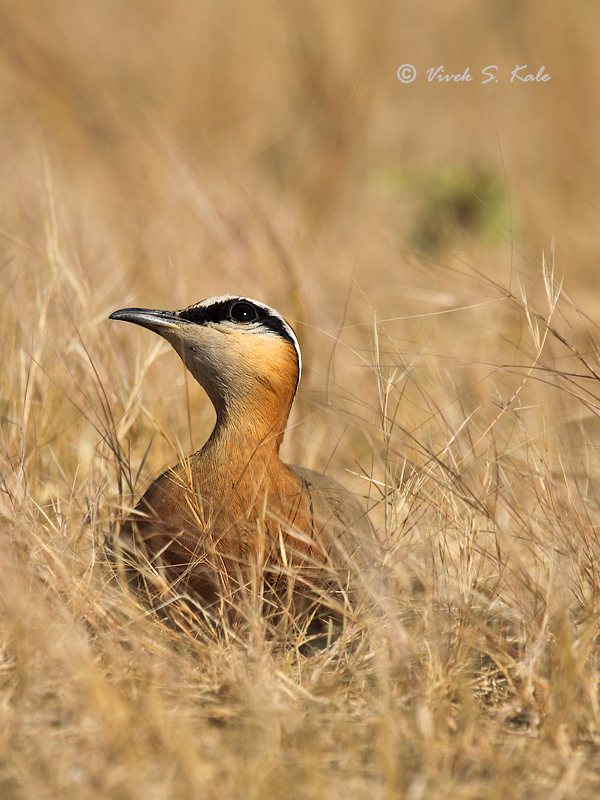 |
| |
| 19. Indian Courser, Dry grassland, Pune district, Maharashtra, India |
| |
|
|
| |
 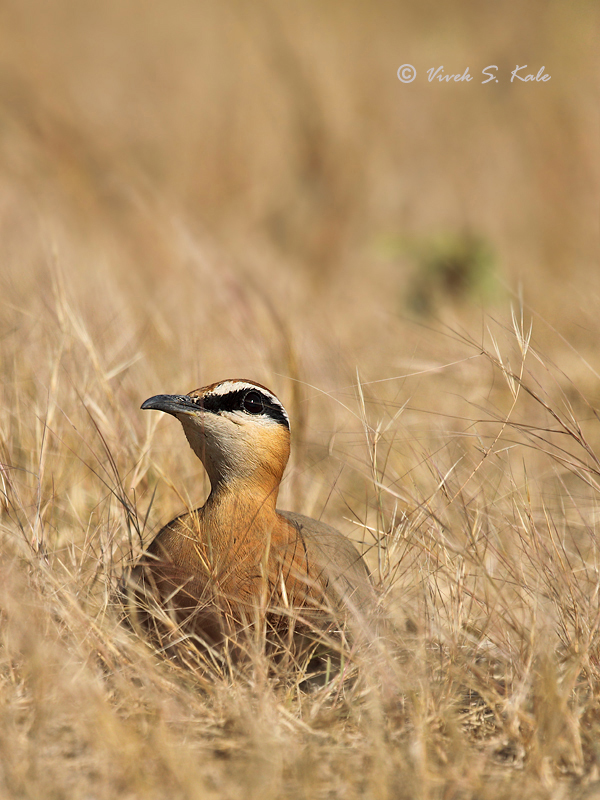 |
| |
| 20. Indian Courser, Dry grassland, Pune district, Maharashtra, India |
| |
|
|
| |
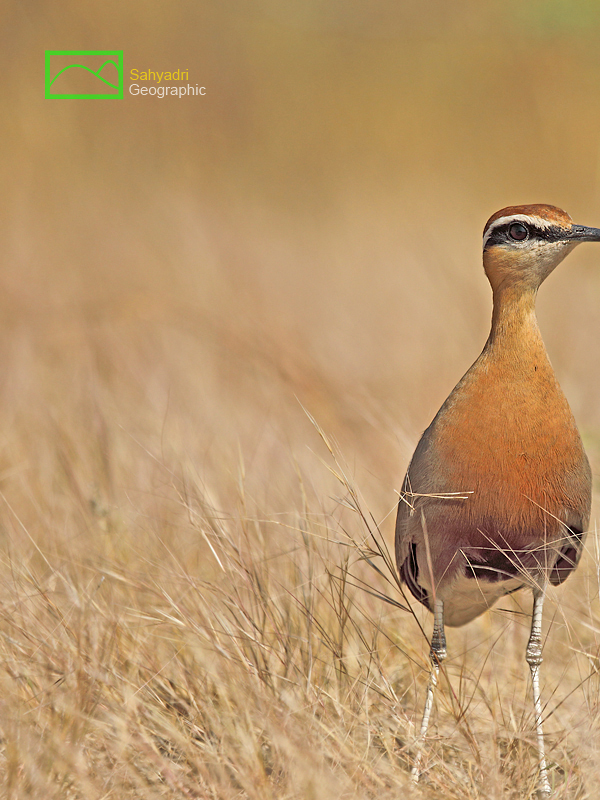 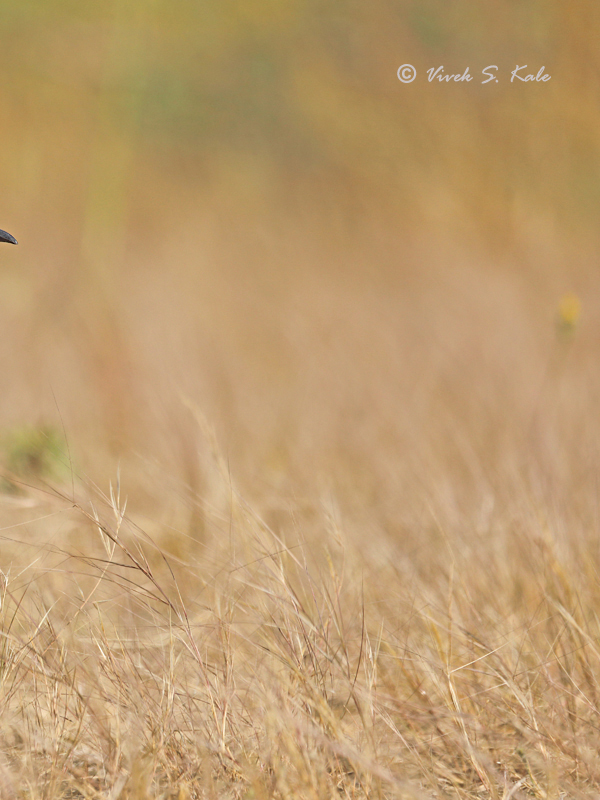 |
| |
| 21. Indian Courser, Dry grassland, Pune district, Maharashtra, India |
| |
|
|
| |
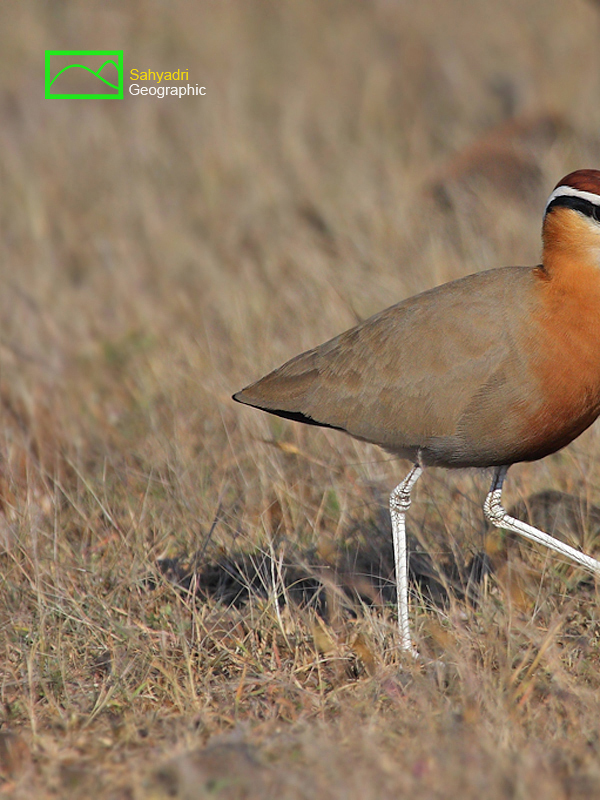 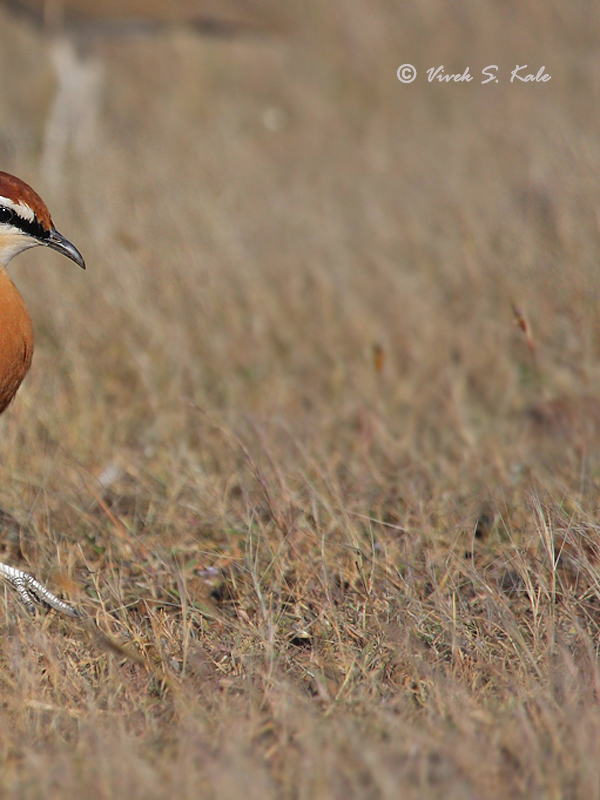 |
| |
| 22. Indian Courser, Dry grassland, Pune district, Maharashtra, India |
| |
|
|
| |
 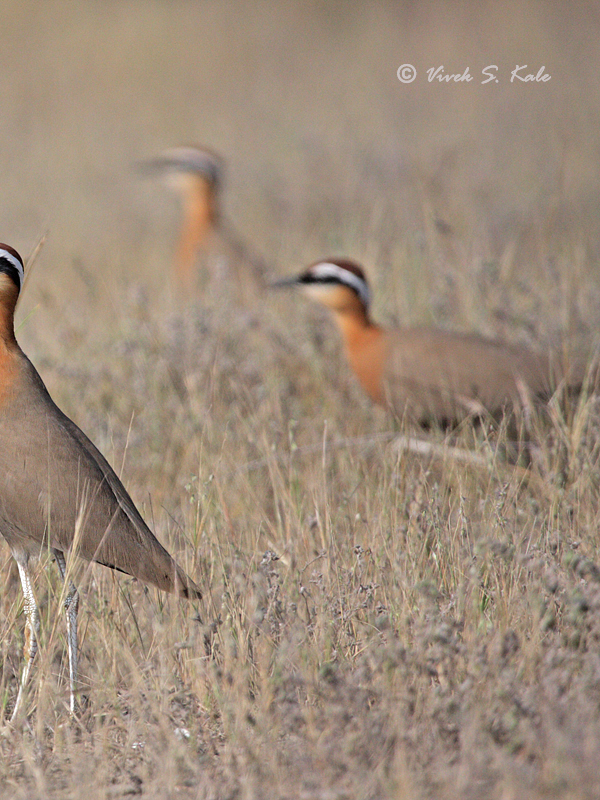 |
| |
| 23. Indian Courser, Dry grassland, Pune district, Maharashtra, India India |
| |
|
|
| |
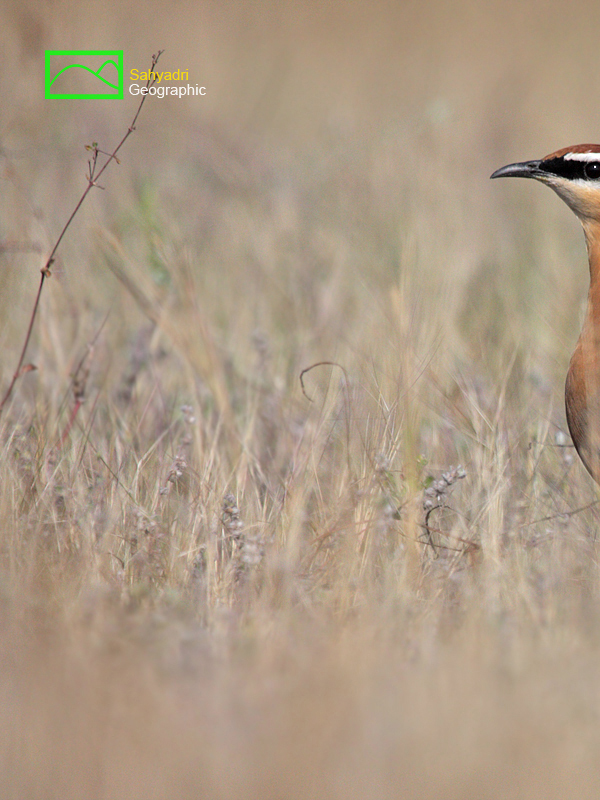 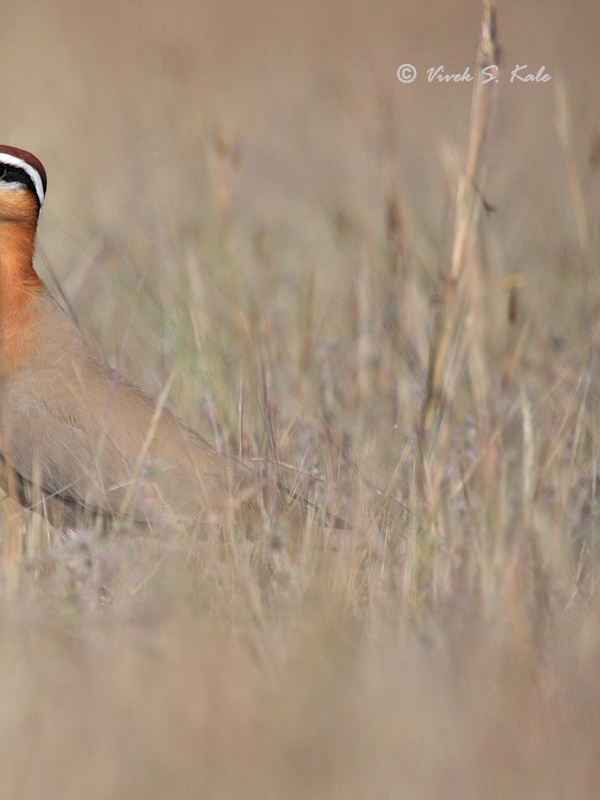 |
| |
| 24. Indian Courser, Dry grassland, Pune district, Maharashtra, India |
| |
|
|
| |
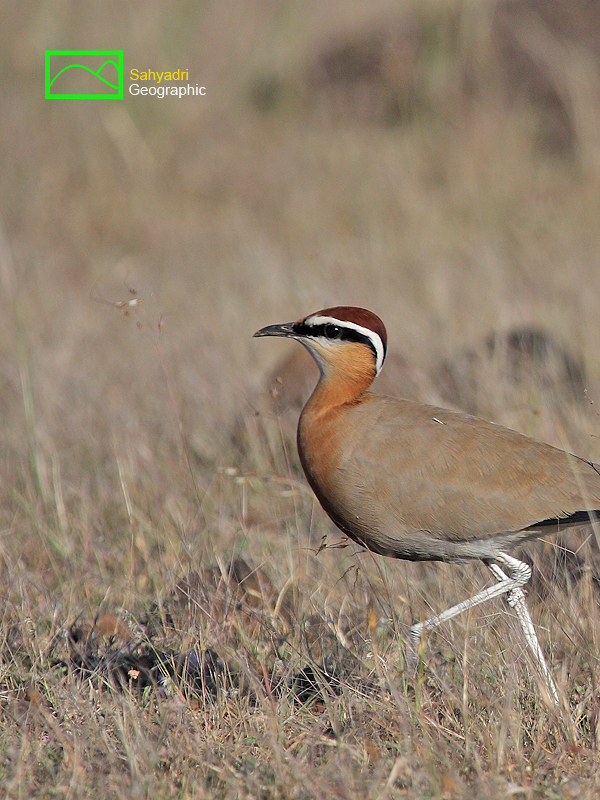 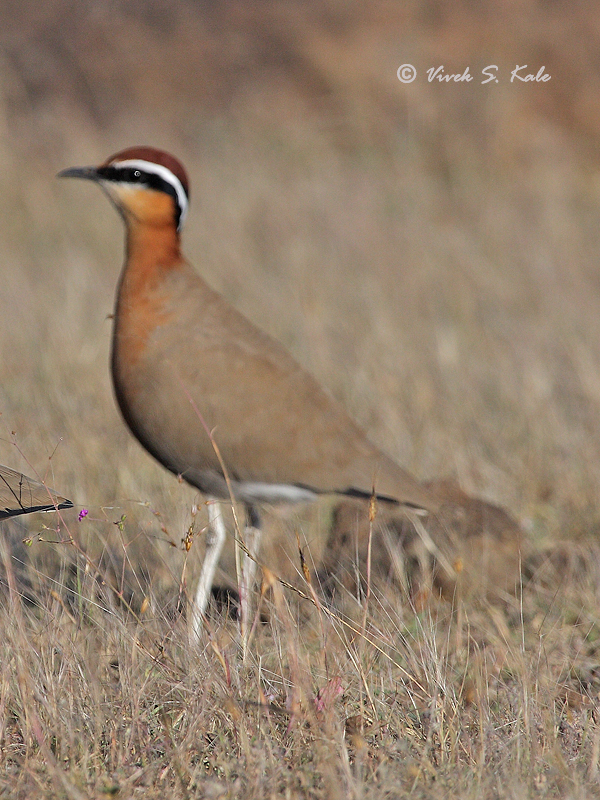 |
| |
| 25. Indian Courser, Dry grassland, Pune district, Maharashtra, India |
| |
|
|
| |
 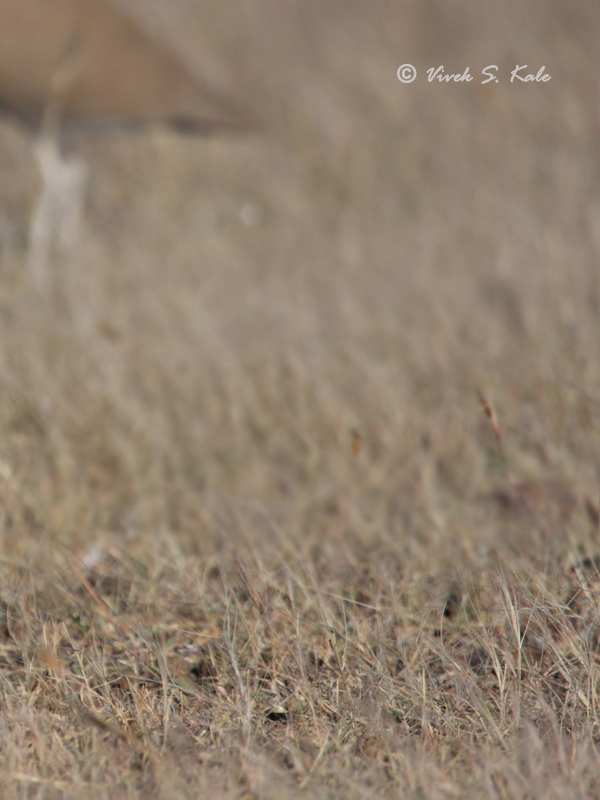 |
| |
| 26. Dry grassland, Pune district, Maharashtra, India |
| |
|
|
| |
|

























































